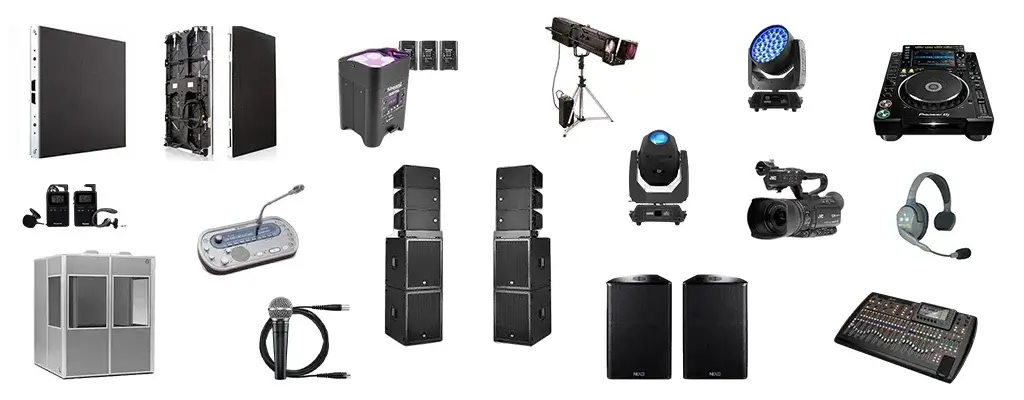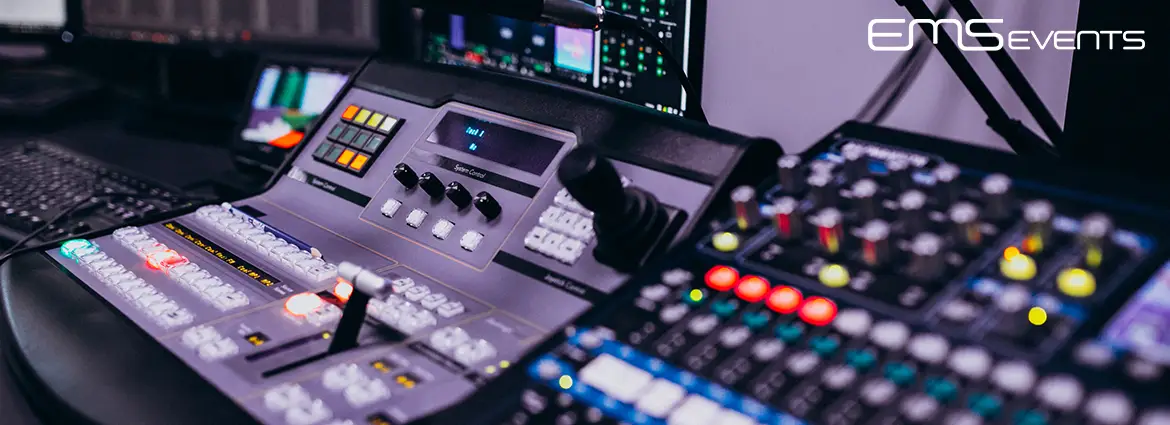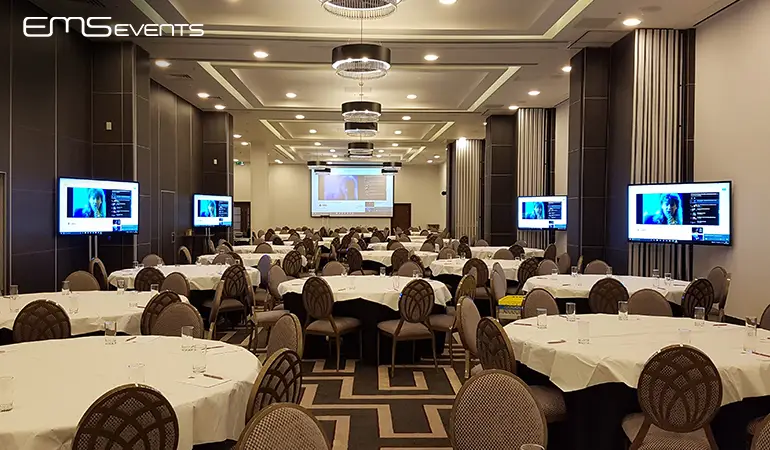Let’s be honest; the selection of audio-visual equipment is not easy. There is a comprehensive list of AV equipment when it comes to event production. Choosing the perfect devices can be daunting without the guidance of a professional event production company. Obviously, with audio visual hire companies offering their services, you do not have to worry about making a wrong choice.
However, it is still prudent to have knowledge about all types of audio visual equipment. This will save the day should the audio-visual adviser fail to mention appropriate options. You don’t have to know about all the options available. But knowing about the latest AV equipment pieces that are making a buzz in the audio-visual industry is a good idea.
This article is about different types of audio-visual equipment used for events. You’ll get to know the examples as well as a list of audio-visual equipment that are necessary. So, let’s start from the basics!
What is audio-visual equipment?
AV equipment is an electronic device that is used to create and improve audio-visual experiences. Typically, audiovisual equipment represents devices that generate, process, or project videos and audio to engage the audience.
Example of Audio-Visual Equipment
As mentioned, AV equipment is any device that improves audio or visual experiences. Prominent examples of audio-visual equipment in the event industry are:
- LED video walls
- Projector screens
- PA and sound systems
- Microphones
There are also various audio-visual equipment used in the hotel industry. After all, these are the most favoured venues for corporate events, meetings, and seminars in the UK.
You’ll find video conferencing systems and even web streaming equipment in large rooms in many hotels. In small meeting spaces, hotels usually have lighting systems, audio systems, screens, and projectors installed.
Different Types of Audio-Visual Equipment
Audio-visual equipment pieces greatly increase the mood and feel of events. AV equipment such as PA systems and LED screens have the ability to draw the audience’s attention and captivate them. We’ve briefly discussed both audio and visual equipment separately for your better understanding.

Audio Equipment for Events
Audio equipment hire is a must for any type of event. Whether there is going to be a speaker or several speakers. Good audio equipment allows the audience to hear clearly from anywhere in the venue. The visual devices often come as an addition, depending on the objectives of the event. However, these days, it’s difficult to find an event that doesn’t have both audio and visual equipment and some sort of lighting.
Before choosing audio-visual equipment for an event, It’s important to know what you’re aiming to achieve and through which AV devices.
For sound, audio-visual service providers have many options, such as microphones and speakers. Thanks to technological advancements, the quality of sound has become clearer and sharper with time. The most recent development is the introduction of wireless audio devices.
For example, wireless microphones are hardly noticeable and can be attached to the speaker’s attire. What makes them tick is the freedom that wireless equipment offers. Speakers and participants can move freely on the stage using wireless mics and headphones.
The current trends in audio equipment include:
- Wireless technology
- High-resolution audio
- Smart speakers
- Hearable devices
- Multifunctional headphones

These new technologies are increasingly finding their use in the audio-visual hire industry. Their inclusion allows a greater experience in sound quality for event participants.
The Best Visual Equipment for Hire
Similar to audio devices, a great revolution is happening in the visual equipment hire market, transforming the event industry. Over the years, we’ve seen the evolution and inclusion of several visual technologies, and at the forefront of this trend are LED video walls. These screens have completely replaced bulky LCD monitors. However, event organisers are still struggling to learn why hire LED screens and how to use them effectively.
Newer visual technologies, especially Extended Reality (XR), are offering greater exposure to audiences at events. In fact, they are offering an immersive experience that completely surrounds the viewer.
The trending visual technologies include:
LED Video Walls: Used for presentation in events, seminars, and exhibitions
Plasma Screens: These flat panels can be used anywhere to display content (textual or imagery) in high-definition resolution.
Virtual Reality and Augmented Reality: These are becoming quite popular at events such as exhibitions for promoting a brand or product. The audience in virtual reality (VR) is immersed fully in an artificial digital environment. Augmented reality (AR) overlays virtual objects in the real-world environment.
Projections Screens: Projectors and projection screens are becoming smaller but more powerful, allowing sharper images.
Projection Mapping: These are audio-visual lighting equipment that lets you overlap videos onto different surfaces.
Visual equipment helps businesses lower their costs when it comes to organizing meetings. Audiovisual technology like teleconferencing allows businesses to communicate with partners or their representatives instantly from anywhere in the world. Hybrid and virtual events have become a reality, thanks to interpretation equipment and live event streaming services.
Audio Visual Requirements for Events
The choice to pick basic audio-visual equipment or pro audio-visual equipment entirely depends on your event cost. Each event has different audio-visual requirements considering the venue, number of attendees, and event nature.
To meet audio-visual requirements, you must create an AV checklist for your event. Check the following:
- Sound system availability
- Microphone (wired and wireless)
- Projector availability
- Video screen readiness
- Laptop, PC, and printer availability
Having a checklist is crucial if you are acquiring IT equipment hire services for hybrid or virtual event production. So, make sure that your chosen event production company has the right equipment for content creation.
Related: How to choose an event production company
What AV equipment is necessary?
As highlighted earlier, it all depends on your individual needs, including the type of event, audience, and budget. There’s no predefined list of audio-visual equipment, as there’s no one-size-fits-all concept in the AV industry. So, the list of necessary AV equipment keeps on changing based on these factors.
For example, for corporate or business meetings, your necessary AV equipment may include:
- Microphones,
- Speakers,
- LED screens,
- Projectors,
- Monitors, and
- video cameras
There are different types of audio-visual equipment that event organizers, managers, and producers use. Some commonly used AV equipment devices are wireless microphones, powered speakers, data projectors, microphone mixers, and digital mixers.
Similarly, different types of audio-visual presentation equipment include:
- Staging equipment
- Projection systems
- Audio systems
- Lighting systems
- LED video walls
- Control systems
- video conferencing systems
In addition to these, you may also need presentation software and sound mixers.
Choosing an Audiovisual Service Provider
Advancements in technology are giving birth to new audio-visual accessories, expanding the list of AV equipment. But the key to a successful event is choosing the right AV company to cater to your audio-visual needs. So, ensure that you hire a professional team with the latest technology equipment.
For this, you must know what event production companies offer.
Also, explain your needs correctly while choosing an audiovisual hire company. This will enable the AV service provider to offer suitable and customized solutions for your event. Above all, you’ll get the best value for your money. From the installation of the equipment on-site to the management, everything will work properly. And you’ll be able to organize and produce your event in a very creative manner.
Final Note
For the success of your event, it’s necessary to choose a team of professional audiovisual service providers. The company should be in tune with the trends in the industry and able to provide advice depending on the type of event you’re having. Only by having very good audiovisual equipment can you make a success of any type of event
